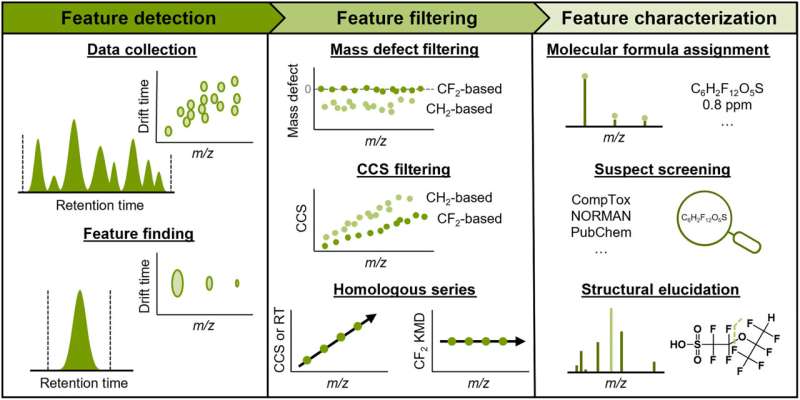October 31, 2023 report
New analytical approach to detecting and characterizing unknown types of PFAS in the environment

Bob Yirka
news contributor

A combined team of chemists from North Carolina State University and the University of North Carolina at Chapel Hill has developed a new approach to detecting and characterizing unknown types of PFAS in the environment. In their paper in the journal Science Advances, the group describes their new approach.
Per-and poly-fluoroalkyl substances (PFAS) are a group of chemicals that have been used to make a wide range of products since the 1940s, including food packaging, cookware and adhesives. Manufacturing processes generally release some of the substances into nearby waterways. But in the 1980s, scientists began to find that PFAS chemicals can be harmful when consumed by humans and animals via drinking water. They also found that PFAS do not break down in the natural environment, leading them to be nicknamed "forever chemicals."
After PFAS became implicated in a wide variety of ailments, governments and other local officials began to crack down on companies that use them, forcing them to stop. And as part of that process, standards were set for testing for PFAS in the natural environment. Testing typically involved collecting water samples and measuring the mass, size and polarity of contaminating chemicals to determine if they were among the known PFAS.
But, as the researchers involved in this new study noted, standards did not account for other chemicals or PFAS in water samples, particularly those that are not even known to government agencies. To overcome this problem, the team added a new testing step that is conducted after standard tests—ion mobility spectrometry. It is a type of a test that can reveal the electrical activity surrounding molecules, which can narrow down and isolate certain types of molecules. In this case, the test was found to be good at finding the kinds of molecules that make up PFAS compounds.
The research team tested their new approach on water samples collected downstream from the Fayetteville Works Plant from the Cape Fear River in North Carolina. The plant is widely known for spewing PFAS chemicals into the river. The researchers discovered 11 PFAS that had not been found in the river before, eight of which were unknown to the EPA.
Written for you by our author —this article is the result of careful human work. We rely on readers like you to keep independent science journalism alive. If this reporting matters to you, please consider a (especially monthly). You'll get an ad-free account as a thank-you.
More information: Kaylie I. Kirkwood-Donelson et al, Uncovering per- and polyfluoroalkyl substances (PFAS) with nontargeted ion mobility spectrometry–mass spectrometry analyses, Science Advances (2023).
Journal information: Science Advances
© 2023 Science X Network



















